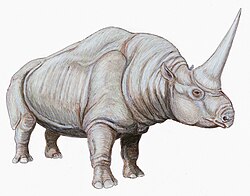Description
Trigonias was about 2.1 metres (6 ft 11 in) long and, despite lacking horns, looked a lot like modern rhinos. The front feet bore 4 toes (as contrasted with three in modern rhinos), the fifth of which was entirely reduced. [5] The median digit was already the largest, whilst the second and the fourth formed a symmetrical pair. The hind feet had only 3 digits. [6]
The shape of the anterior incisors in the upper jaw of Trigonias assume a chisel-like shape. The other 2 incisors are less derived. Trigonias also bore a reduced upper canine, unlike most rhinocerotids. In the lower jaw, the second incisor grew large and tusk-like, and there was no canine. Trigonias also had small premolars when compared to the molars. The dental formula of Triognias was 3,1,4,33,0,4,3 × 2 = 42. [6]
A specimen of T. osborni was estimated to have a weight of about 391 kilograms (862 lb). [7]
Cladogram after Lu, Deng and Pandolfi, 2023: [8]
This page is based on this
Wikipedia article Text is available under the
CC BY-SA 4.0 license; additional terms may apply.
Images, videos and audio are available under their respective licenses.









